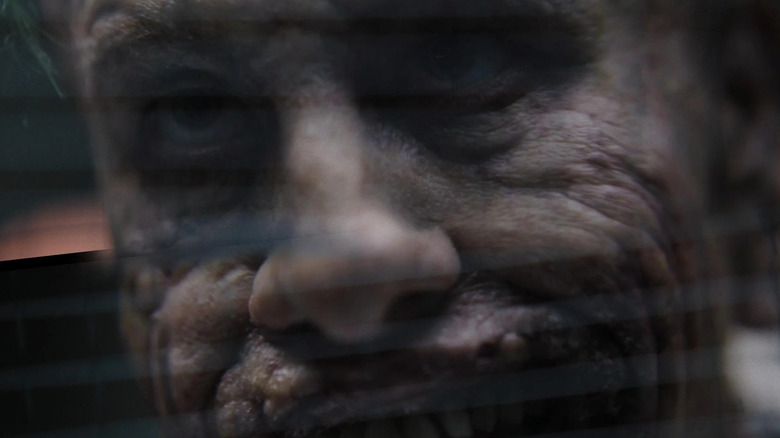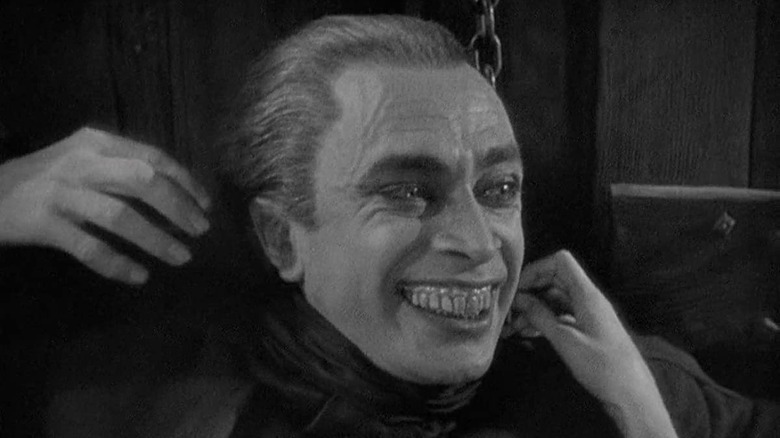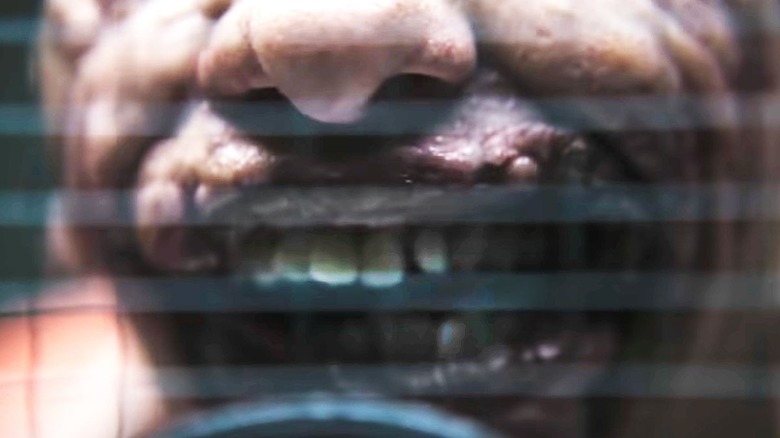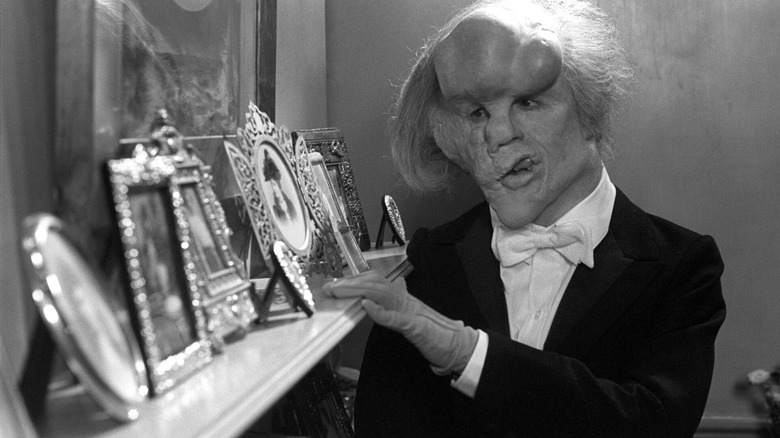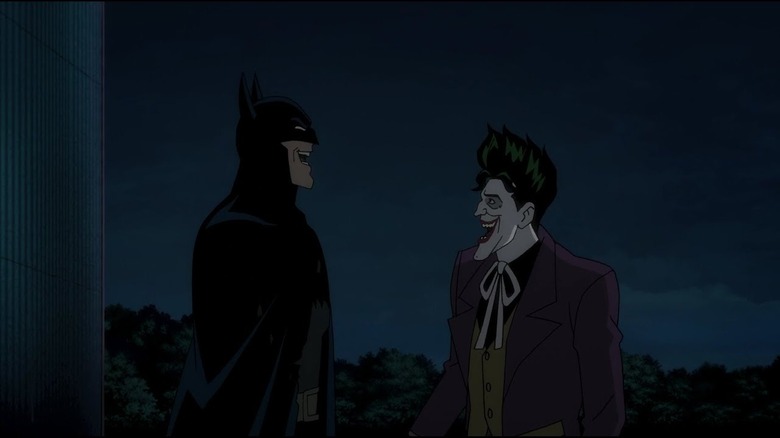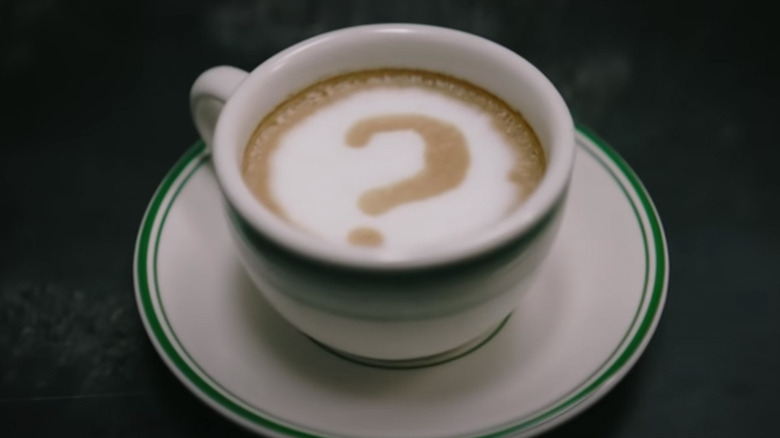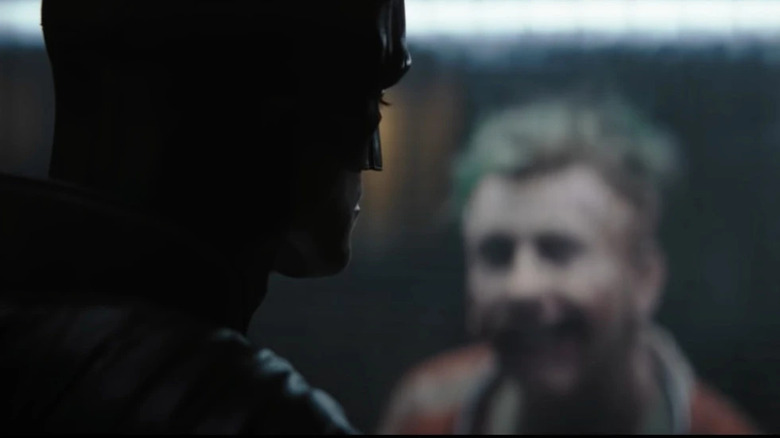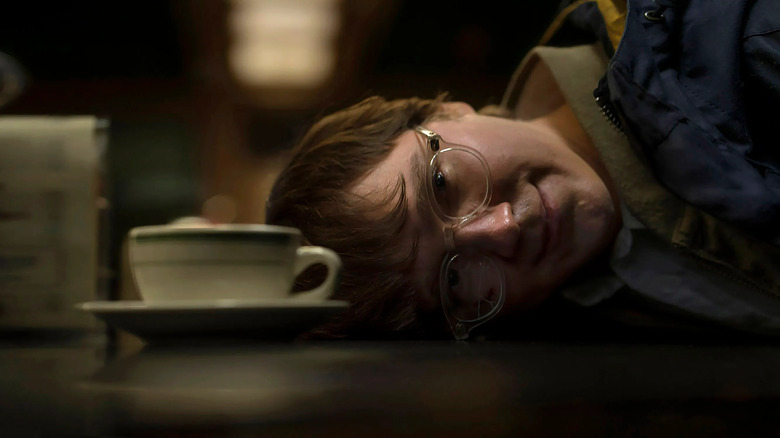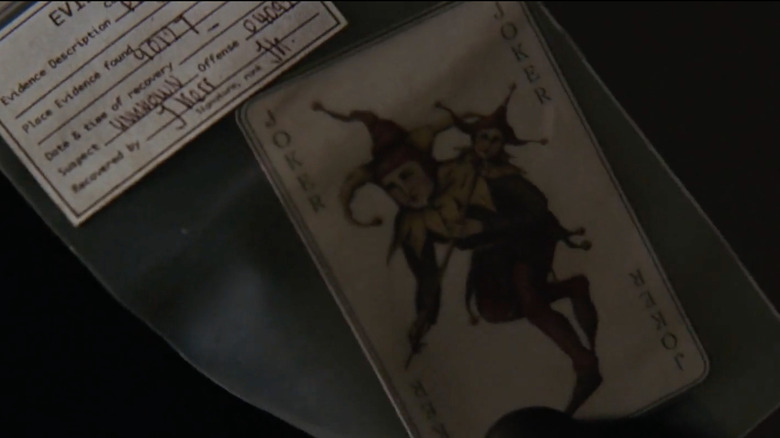The Untold Truth Of Barry Keoghan's Joker From The Batman
Over the past few years, audiences have been given various iterations of the iconic DC comic book villain The Joker. We've had director Christopher Nolan's gritty take on the character in his legendary 2008 film "The Dark Knight," where The Joker was portrayed by the late, great Heath Ledger. The television series "Gotham" has various versions of Mr. J expertly portrayed by Cameron Monaghan between 2014 and 2019. More recently, there was Jared Leto's somewhat divisive take on the character in 2016's "Suicide Squad," and Joaquin Phoenix's show-stopping performance in 2019's "Joker." Matt Reeves's "The Batman" treated us to an even darker, violent, and more realistic tale of the character.
After "The Batman" was released in March 2022, Reeves dropped an extended scene with his version of The Joker, who's played by Barry Keoghan from Marvel's "The Eternals." This new scene, alongside what audiences already got from the character in the film, brought up many questions about this Joker's backstory. Luckily, we've got all the details to break down; here are eight untold truths about The Joker from "The Batman" below.
The Joker's Grin Is Inspired by The Man Who Laughs
In an interview with IGN, Reeves discusses how he took inspiration from the 1928 romantic silent film "The Man Who Laughs." Directed by Paul Leni, the film is adapted from the 1869 novel of the same name by author Victor Hugo. The story follows Gwynplaine (Conrad Veidt), who was forced to undergo surgery as a young boy that placed a permanent smile on his face. He feels deep shame for his disfigurement, but manages to find true love in a blind woman names Dea (Mary Philbin). She believes that she's the only one that can see him for who he truly is.
While Gwynplaine managed to meet someone with good in them, Reeves imagined that The Joker's tale was different. Arguing that the permanent grin twisted his view on the world, as he perhaps didn't have a Dea to keep him grounded. The world shunned him for how he looked, so now he suns the world. For Reeves, he was going back to the comic book roots, as "The Man Who Laughs" is what originally inspired the design of The Joker (per The Direct).
The Joker Has a Biological Condition for His Smile
While Reeves may have taken inspiration from "The Man Who Laughs," he detailed to IGN that the cause of The Joker's smile is not the same experience that Gwynplaine went through in the 1928 film. Instead of being forced to undergo surgery, Reeves states that "He's got this congenital disease. He can never stop smiling."
Reeves thought it was an interesting concept to explore, this idea that "this is something that he's been touched by from birth and that he has a congenital disease that refuses to let him stop smiling? And he's had this very dark reaction to it, and he's had to spend a life of people looking at him in a certain way and he knows how to get into your head." For Reeves, this Joker didn't have a choice but to go a little mad, as though the world was playing a cruel joke on him, and all he could do was laugh.
Although Reeves never outwardly states what the condition is, it's possible that Reeves is alluding to Angelman Syndrome, a genetic disorder that can cause those with the syndrome to smile and laugh frequently. They are also prone to energetic personalities, according to the Mayo Clinic. Of course, The Joker's experience with his condition in "The Batman" takes on a much darker representation than those with the syndrome.
The Joker's Main Source of Inspiration Came From The Elephant Man
Matt Reeves also suggests that his most notable inspiration for his version of The Joker is from David Lynch's 1980 film "The Elephant Man." Like the character Gwynplaine from "The Man Who Laughs" this film follows John Merrick, a man forced to live with deformities in the 1800s. Loosely based on the true-life story of Joseph Carey Merrick, "The Elephant Man" details how the world can be cruel to those who look and are deemed different.
Reeves took this notion to heart, believing that Keoghan's version of The Joker took the cruel joke of being a clown to heart. Reeves tells IGN, "this idea of him being very incisive and brilliant and being able to get into your mind and basically having this nihilistic point of view that's like from his inception, from his birth, life has been a cruel joke on him. And this is his response, and he's eventually going to declare himself as a clown, declare himself as The Joker. That was the idea."
Reeves Made The Joker Sympathetic
Because of his connections to tragic characters like John Merrick in "The Elephant Man" or Gwynplaine from "The Man Who Laughs," Reeves has managed to make his version of The Joker more sympathetic. Rather than Nolan's Joker, who simply loves being an agent of chaos, Keoghan's Joker seems to be more aligned with the 2019 Joaquin Phoenix portrayal of the character. Both versions of The Joker have deep-rooted issues that can gain sympathy from the audience. Both films bring up the idea that it's not entirely their fault, and perhaps society made them this way.
Reeves tells Variety that he always saw his version of The Joker as being something like the character of the Phantom from the "Phantom of the Opera." He's clearly a murderer who deals with psychotic issues, but audiences can still feel and relate to him on some level due to how the world treated the Phantom due to his disfigurement. As Reeves puts it, this idea of a disfigured character being driven to madness isn't new, but it's never truly been explored in a character like The Joker.
Joker Says The Riddler's Iconic Line Riddle Me This
At the end of the film, The Riddler (Paul Dano) is in Arkham and dealing with the fact that Batman (Robert Pattinson) managed to foil his plan. The Riddler truly believed that he and Batman saw eye-to-eye and that they were partners in his plan to take down Gotham. Unfortunately for him, that wasn't the case, and he's left alone in his cell without a friend.
Or is he? Right next door. he hears a voice who utters The Riddler's classic line when he says "riddle me this." Overjoyed that he's found a new friend, The Riddler laughs alongside his neighbor as he's found what he was looking for in Batman.
While the film doesn't outright say it, this is very clearly Keoghan's Joker as he's got the manic laughter and plastered smile to fill audiences in on the joke. After all, just because you're in prison, doesn't mean you can't crack a smile.
There's an Entire 5-Minute Scene Cut Out From the Film
By now, most people are aware that Reeves cut an additional five-minute scene that showcased Pattinson's Batman talking with Keoghan's Joker in Arkham. Batman turned to The Joker to get a leg-up on The Riddler, knowing that The Joker would provide valuable insight to the newest killer to stalk the streets of Gotham. Think "Silence of the Lambs," with Batman being Clarice and The Joker as Hannibal Lecter.
While this scene was ultimately cut, it became available to watch after the release of the film, and it did provide interesting dialogue between the two enemies. The scene showed that there's clear history between the two characters in this world, as Batman has already seemingly caught The Joker. However, in the scene, The Joker manages to steal a paperclip undetected, so perhaps he won't stay locked up for long.
However, the most important thing this scene details is that The Joker is able to grasp The Riddler's plan right away, while Batman doesn't figure it out until it's too late. He tells Batman that perhaps The Riddler writes to Batman because he's a fan and that Batman's the final piece in his puzzle. Batman shrugs this off, but it turns out that the Clown Prince was indeed right. And it's something he figured out in minutes, showcasing how intelligent Keoghan's Joker truly is.
Why the Final Joker Scene Made the Cut
While the 5-minute scene of Batman talking to Keoghan's Joker was cut from the theatrical release of "The Batman," Reeves made a conscious decision to leave the final scene between The Joker and The Riddler in. For the director, it was important to see The Riddler's story end. He states in Apple-exclusive commentary (per TheWrap) that audiences needed to see The Riddler's reaction to his plan not going the way he wanted. And that he was thwarted by Batman, the person he trusted the most, as, in his mind, they were partners.
This scene could also be used as a way to hammer home Selene's (Zoë Kravitz) final option on Gotham. Before leaving, she tells Batman that she doesn't think the city will ever change. She brings up the idea that there's always something worse around the corner, and that Batman will never truly make a difference. The next scene shows The Joker and The Riddler becoming friends, driving her point home — Batman may have won, but in doing so he's brought two criminal geniuses together to potentially wreak more havoc. Can Batman really change Gotham?
The Joker's Scene Doesn't Mean He'll Be in the Next Film
Reeves said in his Apple-exclusive commentary (via TheWrap) "What we'll do with these characters in the future remains to be seen, but it was never meant to be an Easter egg scene, to say like, 'Oh guess who we're using in the next movie.' It was meant to be something delicious for the audience to sort of experience those two characters meeting." For Reeves, having these scenes with The Joker served a purpose, and doesn't necessarily mean that he's setting up for the next film.
The director very much wanted to concentrate on the story that he was telling, but that's not to say that he's ruling anything out for the next film, as he obviously put a lot of care into the character. It just means that the reason behind having Keoghan's Joker was to complete the film's story, and not to build hype over the second film. Plus, over the past few years, audiences have been treated to various films focused on The Joker character, so perhaps Reeves wants to explore other Batman villains that haven't had their debut on the big screen yet.
